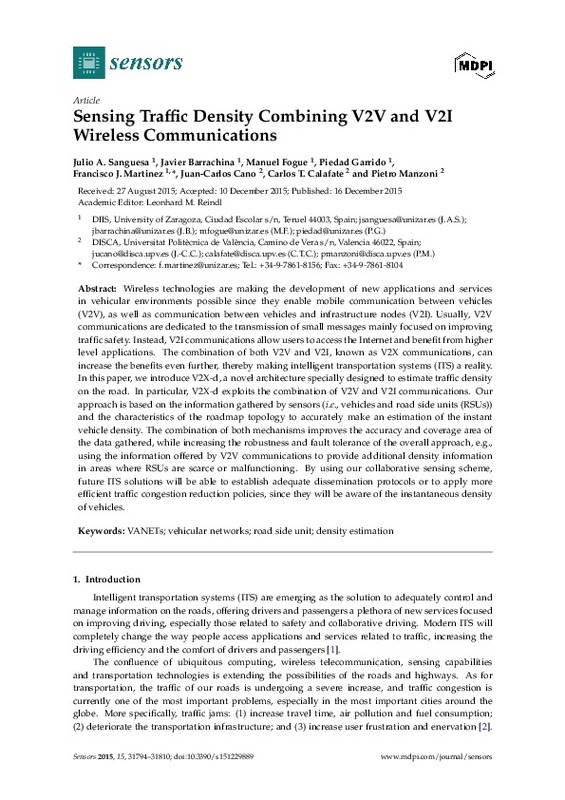JavaScript is disabled for your browser. Some features of this site may not work without it.
Buscar en RiuNet
Listar
Mi cuenta
Estadísticas
Ayuda RiuNet
Admin. UPV
Sensing raffic density combining V2V and V2I wireless communications
Mostrar el registro sencillo del ítem
Ficheros en el ítem
| dc.contributor.author | Sanguesa, Julio A.
|
es_ES |
| dc.contributor.author | Barrachina, Javier
|
es_ES |
| dc.contributor.author | Fogue, Manuel
|
es_ES |
| dc.contributor.author | Garrido, Piedad
|
es_ES |
| dc.contributor.author | Martínez, Francisco J
|
es_ES |
| dc.contributor.author | Cano Escribá, Juan Carlos
|
es_ES |
| dc.contributor.author | Tavares de Araujo Cesariny Calafate, Carlos Miguel
|
es_ES |
| dc.contributor.author | Manzoni, Pietro
|
es_ES |
| dc.date.accessioned | 2016-05-16T16:13:55Z | |
| dc.date.available | 2016-05-16T16:13:55Z | |
| dc.date.issued | 2015-12 | |
| dc.identifier.issn | 1424-8220 | |
| dc.identifier.uri | http://hdl.handle.net/10251/64125 | |
| dc.description.abstract | [EN] Wireless technologies are making the development of new applications and services in vehicular environments possible since they enable mobile communication between vehicles (V2V), as well as communication between vehicles and infrastructure nodes (V2I). Usually, V2V communications are dedicated to the transmission of small messages mainly focused on improving traffic safety. Instead, V2I communications allow users to access the Internet and benefit from higher level applications. The combination of both V2V and V2I, known as V2X communications, can increase the benefits even further, thereby making intelligent transportation systems (ITS) a reality. In this paper, we introduce V2X-d, a novel architecture specially designed to estimate traffic density on the road. In particular, V2X-d exploits the combination of V2V and V2I communications. Our approach is based on the information gathered by sensors (i.e., vehicles and road side units (RSUs)) and the characteristics of the roadmap topology to accurately make an estimation of the instant vehicle density. The combination of both mechanisms improves the accuracy and coverage area of the data gathered, while increasing the robustness and fault tolerance of the overall approach, e.g., using the information offered by V2V communications to provide additional density information in areas where RSUs are scarce or malfunctioning. By using our collaborative sensing scheme, future ITS solutions will be able to establish adequate dissemination protocols or to apply more efficient traffic congestion reduction policies, since they will be aware of the instantaneous density of vehicles. | es_ES |
| dc.description.sponsorship | This work was supported by the Ministerio de Economia y Competitividad, Programa Estatal de Investigacion, Desarrollo e Innovacion Orientada a los Retos de la Sociedad, Proyectos I+D+I 2014, Spain, under Grant TEC2014-52690-R, and by the Government of Aragon and the European Social Fund (T91 Research Group). | en_EN |
| dc.language | Inglés | es_ES |
| dc.publisher | MDPI | es_ES |
| dc.relation.ispartof | Sensors | es_ES |
| dc.rights | Reconocimiento (by) | es_ES |
| dc.subject | VANET's | es_ES |
| dc.subject | Vehicular networks | es_ES |
| dc.subject | Road side unit | es_ES |
| dc.subject | Density estimation | es_ES |
| dc.subject.classification | ARQUITECTURA Y TECNOLOGIA DE COMPUTADORES | es_ES |
| dc.title | Sensing raffic density combining V2V and V2I wireless communications | es_ES |
| dc.type | Artículo | es_ES |
| dc.identifier.doi | 10.3390/s151229889 | |
| dc.relation.projectID | info:eu-repo/grantAgreement/MINECO//TEC2014-52690-R/ES/INTEGRACION DEL SMARTPHONE Y EL VEHICULO PARA CONECTAR CONDUCTORES, SENSORES Y ENTORNO A TRAVES DE UNA ARQUITECTURA DE SERVICIOS FUNCIONALES/ | es_ES |
| dc.rights.accessRights | Abierto | es_ES |
| dc.contributor.affiliation | Universitat Politècnica de València. Departamento de Informática de Sistemas y Computadores - Departament d'Informàtica de Sistemes i Computadors | es_ES |
| dc.description.bibliographicCitation | Sanguesa, JA.; Barrachina, J.; Fogue, M.; Garrido, P.; Martínez, FJ.; Cano Escribá, JC.; Tavares De Araujo Cesariny Calafate, CM.... (2015). Sensing raffic density combining V2V and V2I wireless communications. Sensors. 2015(2015):31794-31810. https://doi.org/10.3390/s151229889 | es_ES |
| dc.description.accrualMethod | S | es_ES |
| dc.relation.publisherversion | http://dx.doi.org/10.3390/s151229889 | es_ES |
| dc.description.upvformatpinicio | 31794 | es_ES |
| dc.description.upvformatpfin | 31810 | es_ES |
| dc.type.version | info:eu-repo/semantics/publishedVersion | es_ES |
| dc.description.volume | 2015 | es_ES |
| dc.description.issue | 2015 | es_ES |
| dc.relation.senia | 298230 | es_ES |
| dc.identifier.pmid | 26694405 | en_EN |
| dc.identifier.pmcid | PMC4721808 | en_EN |
| dc.contributor.funder | Ministerio de Economía y Competitividad | |
| dc.contributor.funder | Gobierno de Aragón |








